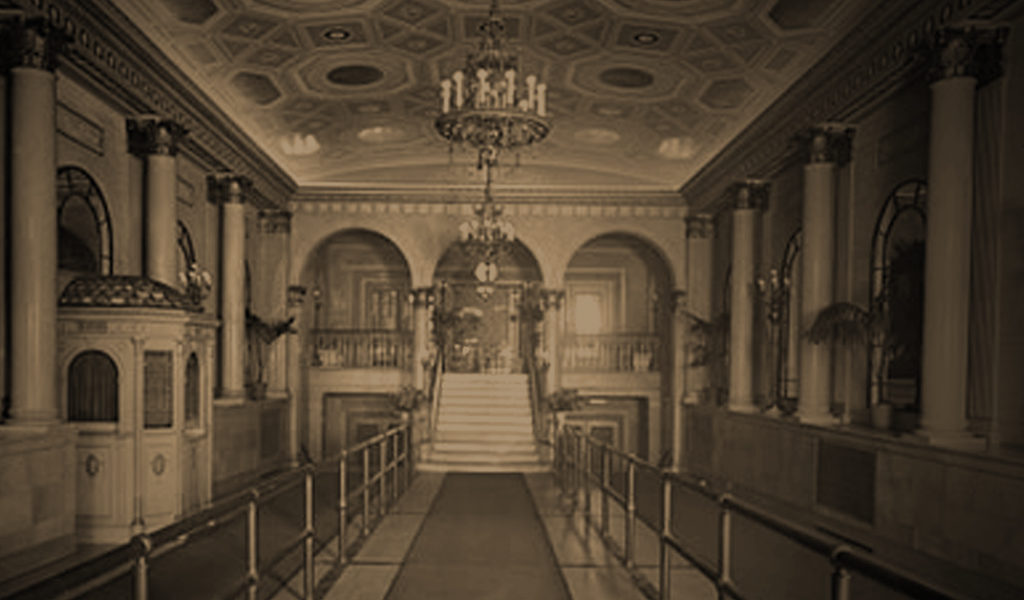The Movies get BIG.
ZekeFilm is 10 years old in 2022! We’re commemorating it with a year-long Film Admissions series wherein each month, we take on a decade (give or take) of cinema, in chronological order. As is always the case with Film Admissions, participants are encouraged to watch a film within that month’s topic that they’ve never seen but have been meaning to. The bigger and more well known the film, the better! Then, together, we share our individual thoughts on our findings.

This time, our reviewers were hard at work, tackling films from 1911-1920. Short films continued to be made available to the public but some of the films became quite longer. Film editing was more creatively employed in storytelling on film.
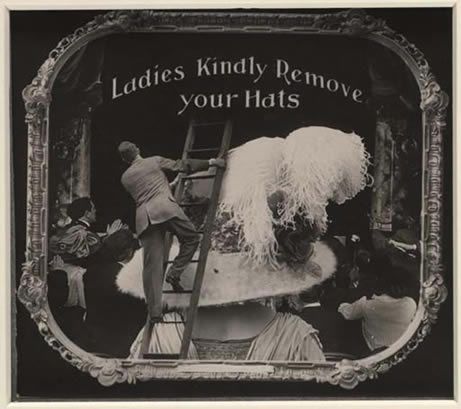
Continuous long shots were intercut with close-ups and medium shots to give audiences focused presentations of the dramas and comedies set before them.
In their seminal work on the history of film, film-historians David Gill (no relation) and Kevin Brownlow point out that there was drama behind the camera as well as in front of it. The group of filmmakers known as a Patents Trust was interested in keeping others from making films and getting a share of the profits. Both the establishment and independent filmmakers employed gangsters to harass and counter the harassment of each other. It was, at least in the first half of the decade, a wild west. And this wild west was in the glamorous locale of Fort Lee, New Jersey, where most films were made in those days.
But some filmmakers decided there would be less harassment in the actual west…California, to be more precise. In 1907, a film studio opened in Los Angeles, 8 miles or so away from Hollywood. Hollywood was itself a fruit orchard and rural community in 1910. But things were about to change so that the films we’ve reviewed this month could be produced.
– David L. Gill
The Birth of a Nation
Directed by D.W. Griffith/1915
by Robert Hornak
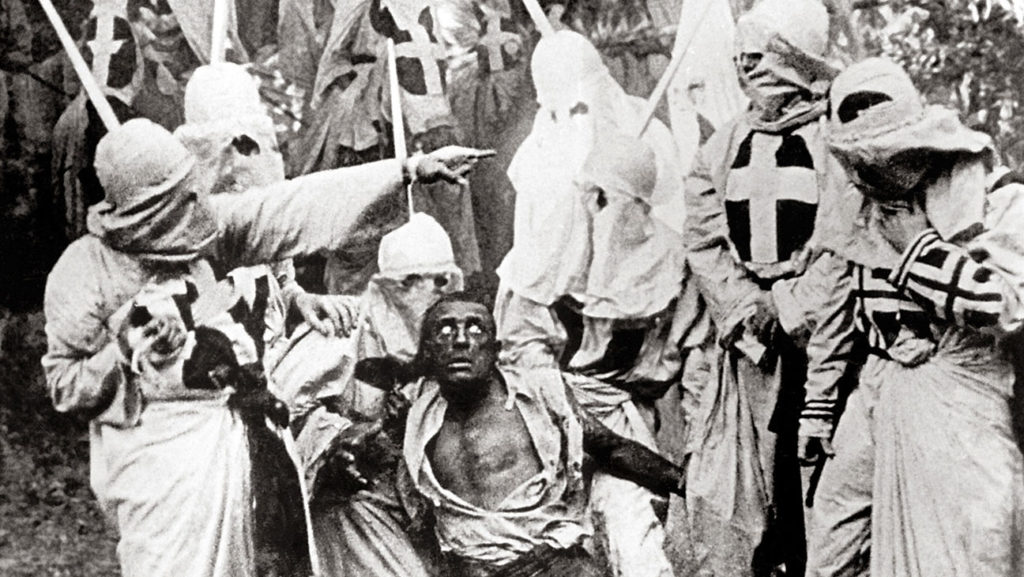
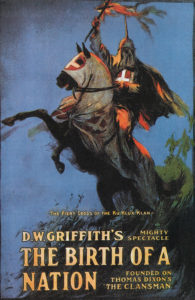
It’s been hard to ignore for a century-plus, including a number of decades since my own birth, and yet it’s only now that I’ve watched it. And it’s exactly what they all say it is: as obvious a misguided and racist transaction as you could imagine, filled from front to back with a near non-stop litany of recoil-worthy assumptions of white supremacy. The top-hatted southern aristocrats milling about in a general head cloud about nothing in particular, while – in the same shot – Black slaves hunch over cotton in the background hat-tipping their benevolent white owners; whites otherwise interacting with preposterously happy Blacks in and around the plantation; Black children joining the fray of celebratory townspeople wishing their white young men well as they go off to fight for their “just cause”… And this is only in the first thirty minutes of a 3-hour screed.
Later, the massive scale of the depictions of Civil War battlegrounds is so impressive – especially from the perspective of our modern assumptions of the limitations of silent-era filmmaking – that we’re momentarily distracted from the fact that the presumed heroes of our story are fighting firmly on the wrong side of history. Griffith proves himself an artist in these sequences, locating the brunt of his considerable visual skills on the horror and waste of war, even calling out the useless loss of life in the intertitles, yet never allowing us to see the south as anything but the noble victim, and so never letting us embrace him as a responsible purveyor of history. That said, it’s an interesting detour from the Confederate flag-waving to include a scene of Lincoln swaying to the tearful entreaties of a condemned soldier’s mother – a flash of magnanimity from “the north” that one wouldn’t expect from a pro-south war film. But then, the movie does its work in making Lincoln the enemy of the radical reconstructionists who wanted the south to pay ultimate prices for its actions, while the south looks to him to be true to his penchant for amnesty and forgiveness.
Beyond the expertly engrossing moments dramatizing Lincoln’s assassination and the somewhat innocuous, extended forays into the romantic lives of various characters, there is an inescapable sense of being lowered into cultish brainwashing in the second half of the film, those nearly two hours that depict post-war reconstruction as a fictionalized, fetishized, what-if version of history that shows Black people as an incompetent, dangerous, sexualized menace that should be held up, in the most egregious sense of the phrase, as a threat to the honorable rule of white, institutionalized America. By the time the ever-loving Ku Klux Klan arrives as de facto cavalry to rescue white damsels from storming blackfaced rapists, we can only see Griffith’s name wilt into the dust heap of cinematic history, hanging on to grace by the single (if prodigious) finger of “but I innovated cinematic technique!” And maybe that’s just enough to stoke the movie’s eternal life on film school syllabi, as long as that honor retains the preface “but he was a stone cold racist” – a fact that will be obvious to anyone watching even a 10-minute stretch of these 193.
Hypocrites
Directed by Lois Weber/1915
by Paul Hibbard
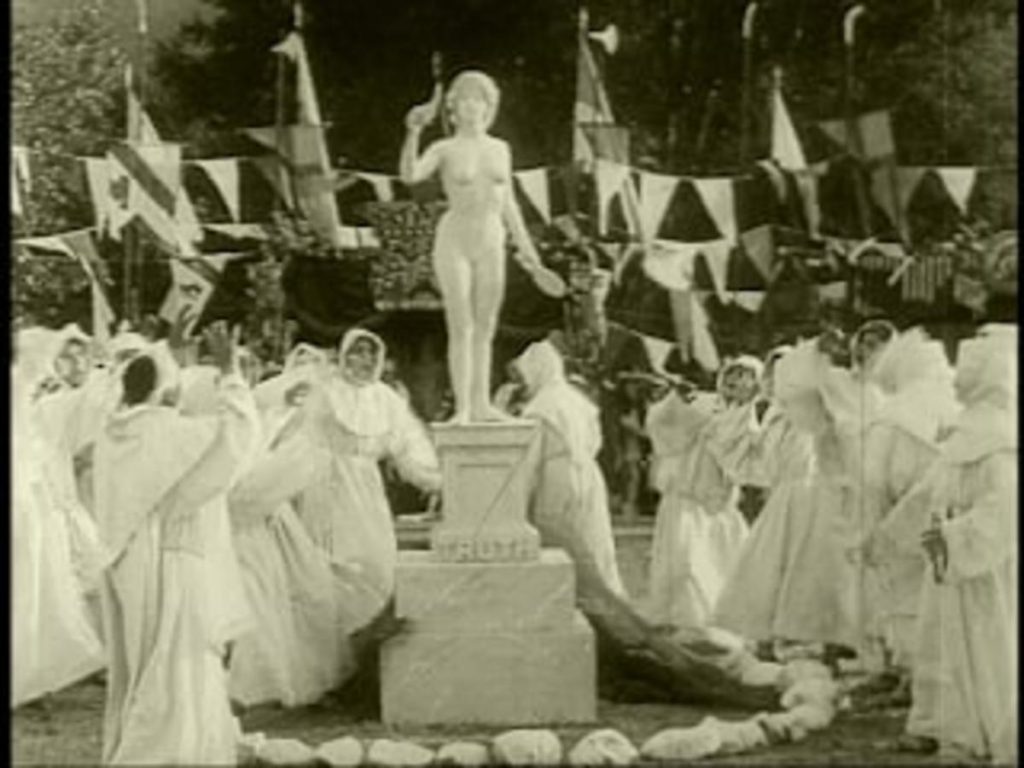
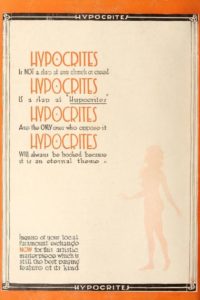
1915 is the year that the so-called landmark film The Birth of a Nation came out. But within the same year, a much better film was released from a filmmaker who was far more interesting than D.W. Griffith, yet the male-lead historian/academic world has tripped over themselves since to overpraise Griffith, because there’s nothing they love more than to have to begrudgingly give credit to a racist, while Lois Weber has fallen into more obscurity.
Weber had made some shorts beforehand, but this was her first foray into feature filmmaking. It’s also, from what I can see, the first film that really played with a more avant garde type of filmmaking, that traded in linear narrative storytelling for a subtext morality tale.
For all the worship that The Birth of a Nation gets, shamefully named along side movies like The Seventh Seal as one of the greatest ever, Hypocrites was much more of a forebear and though artists like Bergman would have arrived with his voice inevitably, Weber paved a bold path that helped lead the way.
Hypocrites is a time-jumping story highlighting the supposed greatest sin man can create, the sin of hypocrisy. From the 1910s to the medieval period and with stops in between, she takes direct aim at the clergy, politicians and the rich. So next time someone speaks of Birth of a Nation as the cinematic equivalent of a Davinci painting, remind them that’s a 3 hour mainstream film mostly filled with whining and self-pitying historical revisions to justify the rise of the KKK, while there were other directors making much more interesting work. Including and especially Lois Weber.
The Clown’s Pup
Directed by Max Fleischer/1919
by Ethan Halker
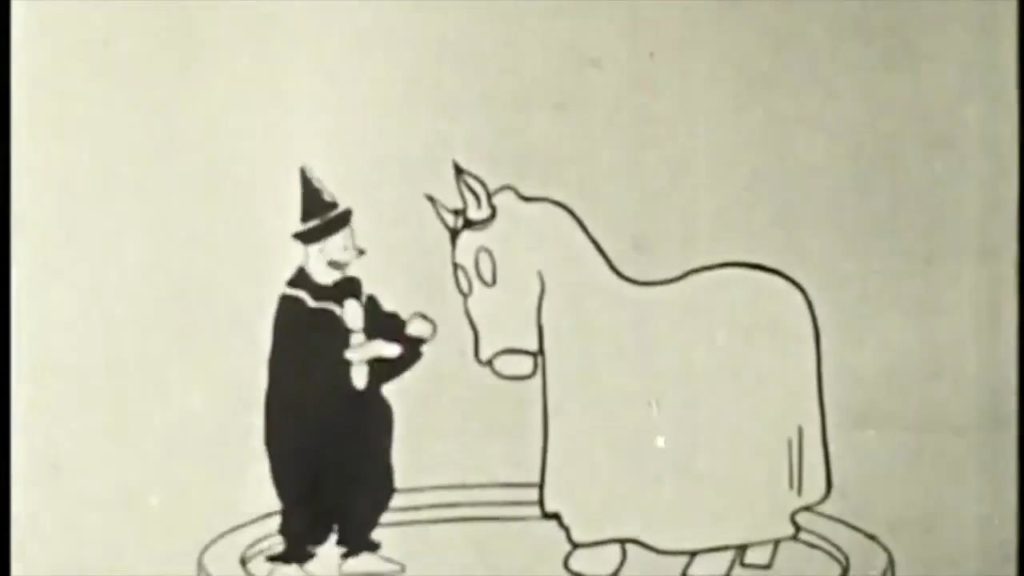
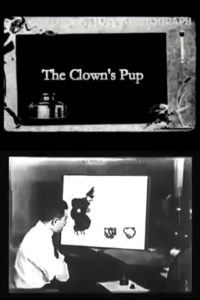
The technical innovations created by the Fleischer brothers – largely by Max – are innumerable and among the most significant in the youth of animation. But the development which towers above the rest is their first, the invention that would allow them to make the first steps towards becoming one of animation’s biggest names in the 20s and 30s; the rotoscope. And with it came a major creative development, in the form of an initially unnamed clown, that would become their first star as Koko.
Certainly, this is mostly old hat to animation enthusiasts. The story of Dave Fleischer donning his clown outfit to serve as reference footage, late nights converting their camera back into a projector and vice-versa, the endless man hours from Max as he tirelessly traced frame after frame of live action footage to bring the animated clown to life. But it is in one of their very first animated shorts, “The Clown’s Pup”, released as a part of the Bray Studios’ catalog of animated shorts, that one immediately recognizes not only the technical aptitude on display, but creativity, but a considerable creativity with form as well.
The short opens on live-action footage of Max, drawing the eponymous clown, in an elaborate sequence of the figure assembling himself before being inked in. The pair exchange barbs regarding the quality of Max’s art in the form of speech balloons for Koko and hand-written responses from Max, before the clown draws a crude dog, Max responding in turn with a more detailed one. The two animals fight, before the clown is caught up in the middle, insisting that Max open up his inkwell before our hand-drawn hero dives back into his home.
The short is brief, even by the standards of the day, at only two minutes forty-eight seconds. The framing is still fun and creative, distinct among its contemporaries and already ripe with potential for gags that the Fleischers are only scratching the surface of. Indeed, the immediate follow-up “The Tantalizing Fly” is generally a much better showcase of both comedy and animation.
Indeed, the craftsmanship is certainly rough around the edges, even compared to the series’ next entry. Occasional use of cut-outs can be noticeable but not egregious. The dogs are crudely animated and more representative of other Bray series, and the dialogue between Max and the clown is clearly a means of reducing the number of traced frames needed. The wide shots featuring Max and the clown suffer from slightly weak compositing, and their inability to have live-action and illustrated figures move on screen at the same time, an issue that would be later resolved with the development of the rotograph.
And yet, there is still a strange sort of magic to this short’s crudity. The assembly of the clown is endlessly charming, and remarkably fluid, particularly in the way it plays with lines transforming into parts of the clown’s outfit. And the fluidity is remarkable, certainly somewhat uncanny, but something about Koko’s simple expression and his loose-fitting outfit make it feel so much more natural than other, later uses of the tool.
Compared to other fair offered by Bray at the time it was a major departure, and combined with the more clever ideas and narrative framing on display it’s little wonder that even with weaker entries like this the clown would take on a life of his own, becoming one of the biggest cartoon stars of the 20s. Certainly a significant historical piece, and one that – while far from perfect – is breezy and interesting enough that it holds your attention while providing a good reference point for how the Fleischers would grow and improve their craft in succeeding installments.
Intolerance
Directed by D.W. Griffith/1916
by Taylor Blake
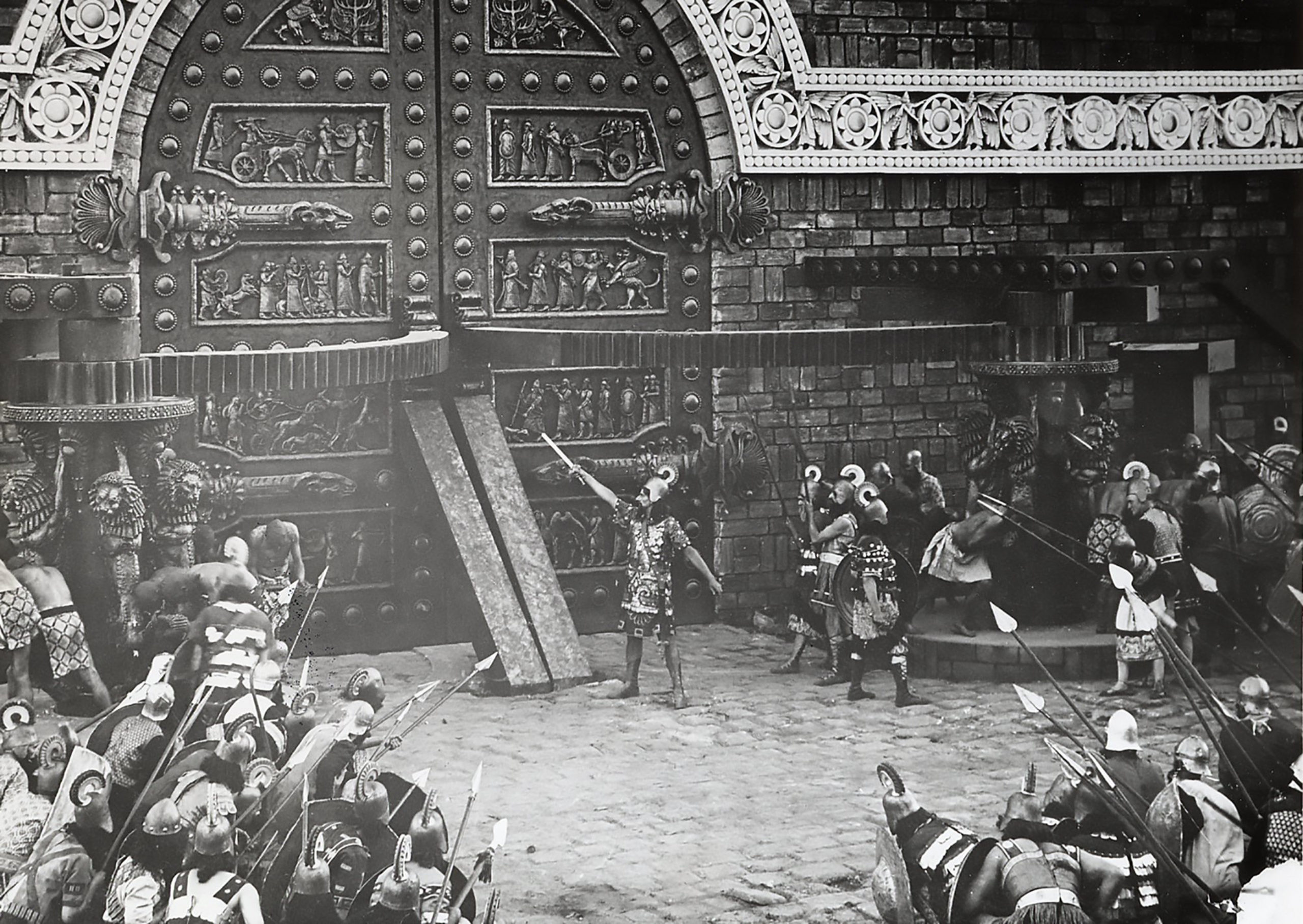
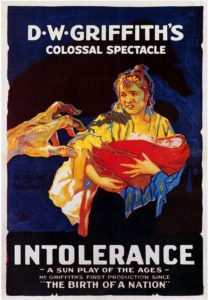
Think silent films aren’t for you? Consider these questions:
• Do you like historical epics?
• Do you appreciate the multiple storylines of Love Actually?
• Are you a fan of the political heavy-handedness of Adam McKay?
If you answered yes to any of the above, then you need to try Intolerance!
Okay, I kid—D.W. Griffith’s 1916 three-hour film is a challenge for viewers a century later, even for those of us making a point to watch every film in the AFI Top 100. Though not as crude in style as the flicks in our last Film Admissions installment, 1910s filmmaking is unsophisticated to our eyes, and this one strives neither for efficiency nor subtlety. (We’re operating at the emotional manipulation level of a Hallmark rom-com here.) If silent film isn’t your thing yet, consider starting with other titles on AFI’s list like 1927’s romantic drama Sunrise or 1936’s Charlie Chaplin comedy Modern Times.
With four storylines in ancient Babylon, turn-of-the-epoch Jerusalem, 16th century France, and present-day city slums, a title card declares, “Comes now from the cradle of yesterday, the story of…people, whose lives, though far away from ours, run parallel in their hopes and perplexities.” To its credit, the spectacle of the production still impresses today, even without the glamour of Cecil B. DeMille or the realism of recent classics like Gladiator. Lavish costumes! Huge sets! Thousands of extras! The cast, the runtime, and the emotions are BIG; it was the priciest movie set built yet, and the film’s advertising hyperbolized its size further to entice audiences. Griffith began work on Intolerance before The Birth of a Nation, at first only as the story of a young couple in poverty whose lives are destroyed by a businessman modeled on John D. Rockefeller. To strengthen his message, he added stories of “equally intolerant hypocrites” throughout history: Persia invading a Babylon weakened by religious tribalism, Pharisees sending Jesus to his crucifixion, and Catherine de’ Medici sentencing Huguenots to genocide.
Some suggest Intolerance is Griffith’s apology for the prejudice he put on display in The Birth of a Nation; others think it’s his indignant response to his critics. Either way, it’s impossible to watch it outside the shadow of the film he released a year earlier. If it’s an apology, today we’d call it a fauxpology as it never addresses racism as an example of prejudice; if it’s a self- defense, its lack of self-awareness undercuts its argument. (As an example, one title card reads, “When women cease to attract men, they often turn to reform as a second option,” a throwaway comment loaded enough for a doctoral thesis.)
In spite of Griffith’s complicated cultural legacy, his reputation as an innovator in the art form remains. He launched new techniques or refined earlier ones, including cross-cutting between disparate plots and creating sets that can’t be contained in one shot. It’s possible we wouldn’t be watching stories of ancient drama, intertwined romances, or social issues today in the same way without Intolerance.
Suspense
Directed by Lois Weber/1913
by Jim Tudor
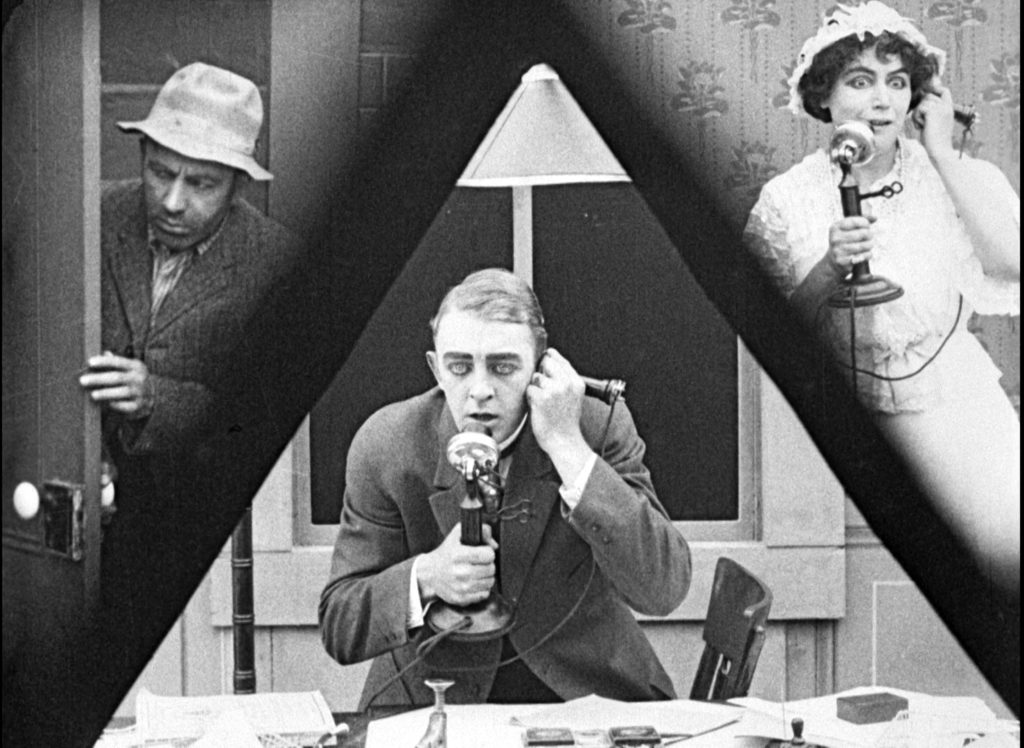
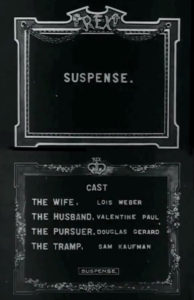
When it comes to the race to solidify what turned out to be the now-inherently understood visual grammar, much of the effort hinged upon… racing. Characters racing against time, to be more exact. The discovery of the basic kinetic thrills inherent from vicariously riding along with a vehicle going top speed is an essential pleasure of the art form- almost as pleasurable as an expressive close-up of compelling actor performing to their strengths. But the true impactful innovation in the early races against time were the cross-cutting between two or more interconnected simultaneous actions/events.
I haven’t done the deconstructive research to determine which early filmmaker originated the art of the cross-cutting race against time, though anyone who took film history courses back in the day know that D.W. Griffith and Cecil B. DeMille tend to get the credit. But what about Lois Weber? The long-overdue movement to reinstate prominent early female filmmakers back into the canon proper has led to the enlightening truth that there was far more formal accomplishment to their work than previously realized or communicated in history books. Weber is someone who found herself more or less scrubbed from the record when the record keeping took a patriarchal turn along with the rest of the evolving (devolving?) movie business.
Weber’s Suspense is a quick and tidy twelve minutes that makes early expert use of all techniques mentioned in this write-up heretofore. For good measure, we also get crazy triangular split screen shots of the central cast members frantically on the phone and whatnot. Weber (who shares directorial credit with her then-husband Phillip Smalley, even though it was really her calling the shots) also stars as the terrorized wife at home, trying to keep herself and her baby safe from a violent, home invading drifter (a scary Sam Kaufman). Her husband (Val Paul) swipes a car to dash home to her rescue, incurring pursuit by the car’s owner, and the police. And that’s pretty much it. Weber seems to have created the generically titled Suspense as an exercise in ginning up the titular state via the cinematic form. Honestly, it’s an excellent little nugget from 1913… predating Griffith’s celebrated cross-cutting climax of Intolerance by three years. That film certainly has a lot going for it as well, but when it comes to technically demonstrative film studies, Weber’s Suspense is exponentially shorter… and perhaps as important.
Les vampires
Directed by Louis Feuillade/1915
by Jeffrey Knight
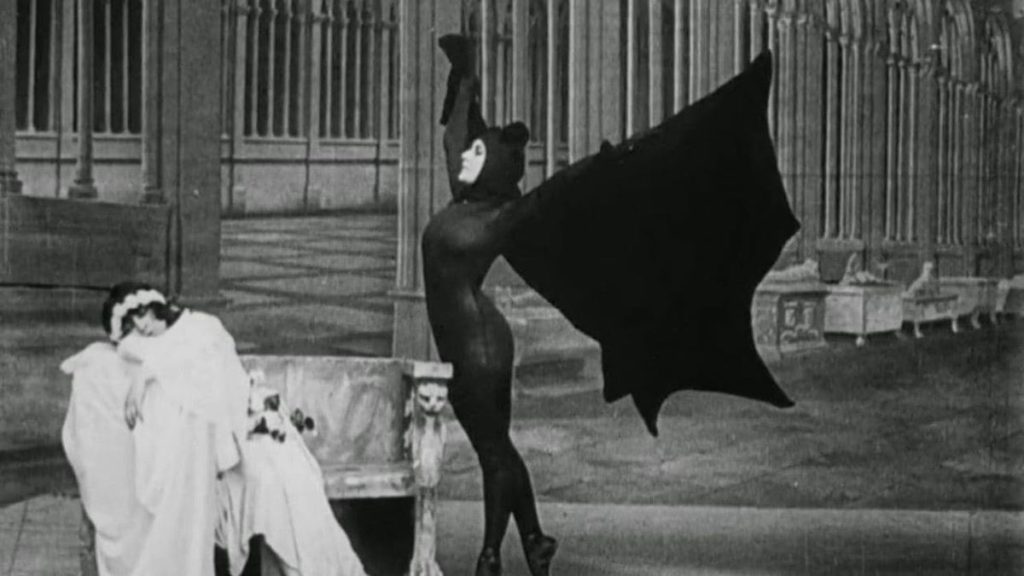
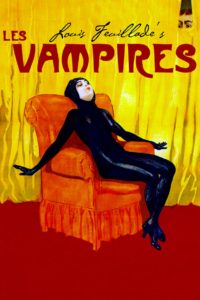
A short paragraph or two (or three) seems so insignificant next to the seven plus hours of 1916’s crime serial Les vampires. Split into ten chapters, with runtimes between 15 and 55 minutes, Les vampires tells the story of intrepid reporter Philippe Guérande (Édouard Mathé) who is investigating the Parisian criminal syndicate known as the Vampires. Led by a man known only as ‘The Grand Vampire’ (initially Jean Aymé) and his right-hand henchwoman Irma Vep (Musidora, an acrobat who did her own stunts), the Vampires burgle, assassinate, scam, and thieve and no one seems to be able to stop them. Guérande, with the able assistance of a former Vampire, Mazamette (the impressively-snozzed Marcel Lévesque), is able to put the pressure on the gang and they soon turn their nefarious attentions on him. The resultant conflict plays out over the course of the film’s ten chapters.
Unlike classic serials modern audiences might be familiar with, the chapters in Les vampires do not end in cliffhangers. Though the villains (often, but not always) escape to vex our heroes another day, whatever conflicts are introduced in the chapter’s start are wrapped up by the end. In that respect, Les vampires has more in common with an episodic television show, particularly with certain Saturday morning cartoons (although with more death and sex than a cartoon would normally permit). Continuity between episodes is sometimes spotty. A villain introduced early on as just a normal thief would soon be revealed to have magical hypnosis powers. The number of children Mazamette claims would vary from chapter to chapter (though it should be said that when we finally meet Mazamette the younger, the little shit brings a delightful anarchic energy to the story).
Les Vampires is a great deal of fun. Its chapters plunge headlong in an ‘anything goes’ sort of manner. It’s writer and director, Louis Feuillade, was coming off his previous success, the serial Fantomas, and found that a rival company was working on their own. He shot Les Vampires quickly to beat his rivals to the punch, and that often meant making things up as they went along with very little story scripted. An actor was fired for habitual tardiness, and his character ends up dead the next chapter. Feuillade had to splice in scenes from a completely different movie to complete one episode thanks to wartime shortages on film. Les Vampires just don’t care, baby!
The Cabinet of Dr. Caligari
Directed by Robert Wiene/1920
by Max Foizey
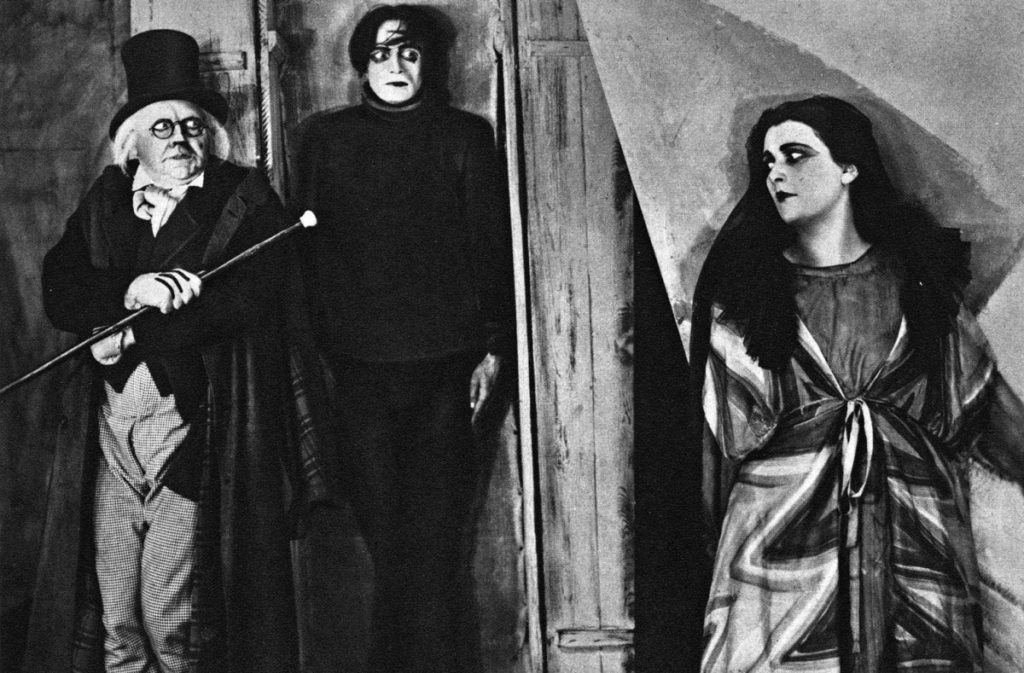
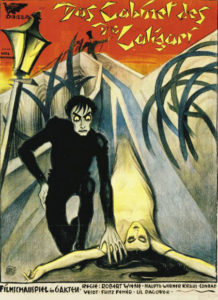
Sanity is tenuous, death the only cure.
There is a fantastic sequence in The Cabinet of Dr. Caligari that features the titular character’s madness illustrated by text displayed on screen, floating menacingly around his person. I was shocked to see this seemingly modern device used so effectively from a film that was made over one hundred years ago. Such are the surprises contained in this mysterious cabinet.
A traveling fair of oddities has come to down, bringing sideshows, an organ grinder’s monkey, and eventually, murder. Francis (Friedrich Fehér) and Alan (Hans Heinz v. Twardowski) are pals, both in love with the fair maiden Jane (Lil Dagover). Francis and Alan go to the sideshow that has descended upon their town and wind up in a crowded tent watching Dr. Caligari’s (Werner Krauss) presentation.
Caligari stands next to a huge coffin shaped cabinet, which he opens to reveal Cesare (Conrad Veidt), a thin man dressed in black, his eyes covered in shadow. Caligari tells the crowd Cesare is a somnambulist, someone who has spent much of their life in a dream state. Caligari beckons the crowd to ask Cesare questions, as he claims once he is awakened, he can tell their fortunes.
Alan asks how long he will live, to which the somnambulist replies “You will die at dawn.” Alan and Francis leave, shaken. Alan is in fact murdered that night, by a strange figure wielding a knife. Upon learning of his friend’s death, Francis is convinced Caligari is responsible. He and Jane ask her father, Dr. Olsen (Rudolf Lettinger), for help. The trio go to the police, who agree to investigate Caligari. An arrest, an attempted kidnapping, and a twist ending follow.
The original German distribution print is lost, so the first reel of the film is pieced together from different surviving prints. But it’s easy to follow, and the version I watched via a streaming service was even in 4K. The intertitles themselves are highly stylized and fit perfectly with the expressionistic vision of the film. Depending on the format or year of release, it’s a safe bet you’re going to hear different scores accompanying silent films. The version I watched had music that was mostly on point, though the kidnapping scene is backed inexplicably by jaunty music that is out of place.
The Cabinet of Dr. Caligari is perhaps most remembered for its striking painted sets, courtesy of Production Designers Walter Reimann, Hermann Warm, and Walter Röhrig, which add a woozy nightmare quality to the film. The characters seem to exist inside melting paintings, though they take no notice to the weird streetlights and misshapen windows. This is simply the world in which they live. Their building’s doors just big enough for them to pass through, their clothes from different eras. The costumes are wonderful, with Cesare’s look predicting Peter Murphy of Bauhaus, and Caligari a probable template for Tim Burton’s Penguin in Batman Returns.
Director Robert Wiene uses iris shots constantly, leading the viewer to feel like they are a voyeur to the strange proceedings. Screenwriters Carl Mayer and Hans Janowitz weave a twisting treatise on insanity, subjective reality, and free will. Even at the conclusion of the film, it’s not clear what is “true,” cementing the unsettling nature of the picture. You’re never sure if you are watching real events or if you are privy to a particularly nasty dream.
J’accuse
Directed by Abel Gance/1919
by David L. Gill

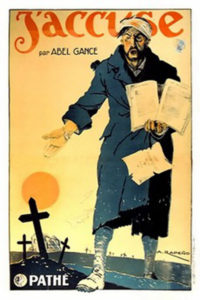
J’accuse is a tale of the first World War and two men who love one woman who find themselves entangled in it.
Poet Jean Diaz and manly-man Francois are at odds because Francois married Edith, the woman that Jean loved. Jean and Francois are both presented as complicated characters. Francois seems a bit of a cruel, angry drunk. Jean is a writer who is carrying on an affair with Edith under Francois’ nose. In serving in the war together, Jean & Francois become friends though Jean and Edith’s closeness still makes him uncomfortable.
The images are often beautifully photographed. Gance knew what to do with his camera operators and the visuals are impressive throughout. The acting is stylized with realistic surroundings and reminds me a great deal of French films from the 1960s such as Au Hasard Balthazar. Tinting and toning are used to set the time of day or emotional timbre of scenes throughout the film. It’s an engrossing experience and a worthy triumph by the director who would go on to create Napoleon only eight or so years later.
Even so, I found the film to be unbelievable. Francois, who is literally painted as little better than an angry dog in the first half or so of the film is supposed to be able to have emotions other than anger—even love? These two men who are so at odds are supposed to become friends apart from serious conversations about infidelity and apologies from Jean? I don’t believe it for a moment. Gance has made a caricature for Francois and I can’t relinquish the images of the first half. War changes men, or so I’ve heard—but I just don’t believe that Francois experiences anything in war to make him softer toward his wife. He’s a hard man who punches through a window while trying to intimidate Edith in the first ten minutes of the film.
Edith’s father, Maria (yes, his name is Maria) is a xenophobic traditionalist who has a great deal of reverence for his time in the military during the 1870s. He desires to be involved yet again. He seems cold toward his daughter, but once Jean and Francois are at the front, he gets very romantically chummy with Jean’s mother. When it seems like he’s one of the more believable characters of the film, Edith comes home after having been raped by a German soldier and with a granddaughter for Maria in tow. Rather than get to know his new family member, Maria leaves—apparently so disgusted with the idea of having an illegitimate grandchild that he’d rather go fight and kill Germans than to get to know this precious child.
Gance’s film is pretentious. It’s also beautiful and worthy of at least two viewings. I don’t believe that it lives up to its hype, but it is certainly grand in scale, asking grand questions of whether or not humankind ought to kill each other in war and answering them with an ugly, guttural ‘no’. There are no real heroes in this film. Not a single person is above reproach—a theme Gance touches on in the final fifteen minutes of the film wherein Jean has what is essentially and ecstatic, prophetic utterance in front of the townspeople where he questions the character of those who stayed behind—not because they dodged the draft but because their daily carryings-on are beneath the dignity of the ones who sacrificed themselves that those who remained behind might live.
But even in that scene, Jean absolves the crowd of their guilt in a way that feels too glib. As with Jean and Francois, there is no apology—no repentance. And that is where the film falls short. For even in the cessation of hostilities which brought the war to an end originally, there was little if any repentance and the specters of that war came to life again twenty years later.


